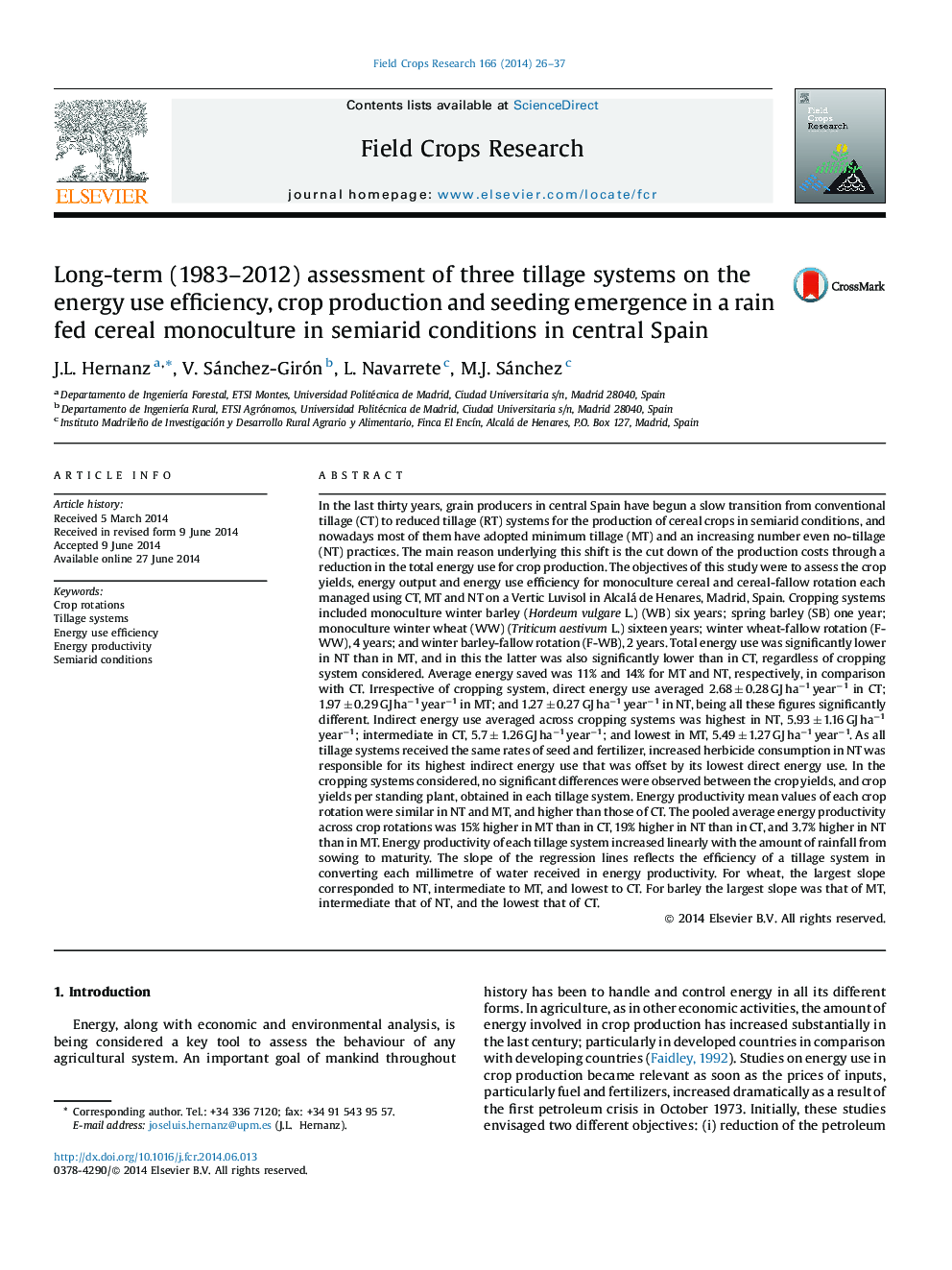| کد مقاله | کد نشریه | سال انتشار | مقاله انگلیسی | نسخه تمام متن |
|---|---|---|---|---|
| 4509988 | 1624697 | 2014 | 12 صفحه PDF | دانلود رایگان |

• The energy consumption and energy use efficiency of conventional, minimum and no-tillage were assessed for rainfed crops in a long-term, 29 years, experiment for semiarid conditions.
• No-tillage provided significant direct use energy savings for all the cropping systems considered followed by minimum tillage and conventional tillage.
• In the cropping systems considered, no significant differences were observed between mean yields, number of standing plants and crop production per standing plant in each tillage system.
• A direct and significant correlation between energy productivity and rainfall from sowing to crop maturity is envisaged.
In the last thirty years, grain producers in central Spain have begun a slow transition from conventional tillage (CT) to reduced tillage (RT) systems for the production of cereal crops in semiarid conditions, and nowadays most of them have adopted minimum tillage (MT) and an increasing number even no-tillage (NT) practices. The main reason underlying this shift is the cut down of the production costs through a reduction in the total energy use for crop production. The objectives of this study were to assess the crop yields, energy output and energy use efficiency for monoculture cereal and cereal-fallow rotation each managed using CT, MT and NT on a Vertic Luvisol in Alcalá de Henares, Madrid, Spain. Cropping systems included monoculture winter barley (Hordeum vulgare L.) (WB) six years; spring barley (SB) one year; monoculture winter wheat (WW) (Triticum aestivum L.) sixteen years; winter wheat-fallow rotation (F-WW), 4 years; and winter barley-fallow rotation (F-WB), 2 years. Total energy use was significantly lower in NT than in MT, and in this the latter was also significantly lower than in CT, regardless of cropping system considered. Average energy saved was 11% and 14% for MT and NT, respectively, in comparison with CT. Irrespective of cropping system, direct energy use averaged 2.68 ± 0.28 GJ ha−1 year−1 in CT; 1.97 ± 0.29 GJ ha−1 year−1 in MT; and 1.27 ± 0.27 GJ ha−1 year−1 in NT, being all these figures significantly different. Indirect energy use averaged across cropping systems was highest in NT, 5.93 ± 1.16 GJ ha−1 year−1; intermediate in CT, 5.7 ± 1.26 GJ ha−1 year−1; and lowest in MT, 5.49 ± 1.27 GJ ha−1 year−1. As all tillage systems received the same rates of seed and fertilizer, increased herbicide consumption in NT was responsible for its highest indirect energy use that was offset by its lowest direct energy use. In the cropping systems considered, no significant differences were observed between the crop yields, and crop yields per standing plant, obtained in each tillage system. Energy productivity mean values of each crop rotation were similar in NT and MT, and higher than those of CT. The pooled average energy productivity across crop rotations was 15% higher in MT than in CT, 19% higher in NT than in CT, and 3.7% higher in NT than in MT. Energy productivity of each tillage system increased linearly with the amount of rainfall from sowing to maturity. The slope of the regression lines reflects the efficiency of a tillage system in converting each millimetre of water received in energy productivity. For wheat, the largest slope corresponded to NT, intermediate to MT, and lowest to CT. For barley the largest slope was that of MT, intermediate that of NT, and the lowest that of CT.
Journal: Field Crops Research - Volume 166, September 2014, Pages 26–37